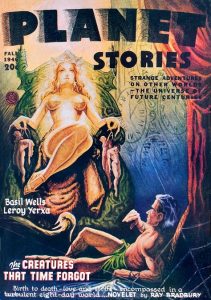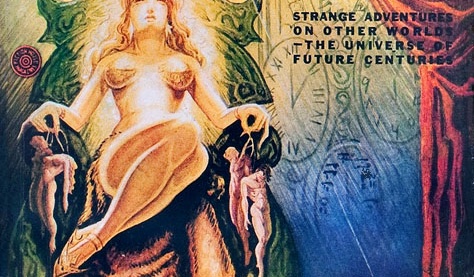 Ray Douglas Bradbury was born on August 22, 1920, in Waukegan, Illinois. From an early age, he was a voracious reader and consumer of popular culture — movies, pulp magazines, radio programming, newspaper comic strips, circuses, magic, and more. He was enamored with the Buck Rogers newspaper strip, the stories of L. Frank Baum, Edgar Rice Burroughs, and more. By age twelve, he wanted to write.
Ray Douglas Bradbury was born on August 22, 1920, in Waukegan, Illinois. From an early age, he was a voracious reader and consumer of popular culture — movies, pulp magazines, radio programming, newspaper comic strips, circuses, magic, and more. He was enamored with the Buck Rogers newspaper strip, the stories of L. Frank Baum, Edgar Rice Burroughs, and more. By age twelve, he wanted to write.
After his family moved to Los Angeles in 1934, the teenaged Bradbury discovered science fiction fandom. Through the Los Angeles Science Fiction Society, he met such people as Forrest J Ackerman, Hannes Bok, Leigh Brackett, Ray Harryhausen, Henry Hasse, Robert A. Heinlein, and Henry Kuttner. It was Kuttner, in particular, who took the young Bradbury under his wing, urging him to read more outside the fields of science fiction and fantasy, critiquing his stories, and advising the budding author to simply “shut up and write.”
Ray Bradbury sold his first story in 1941. A collaboration with Henry Hasse, “Pendulum” was based on a work originally published in Bradbury’s own fanzine, FUTURE FANTASIA. The two authors would sell two other collaborations before the younger Bradbury set off on his own.
With the help of Kuttner and fellow writer Leigh Brackett, as well as literary agent Julius Schwartz, Bradbury began to find regular markets for his fantasy and science fiction in AMAZING STORIES, PLANET STORIES, SUPER SCIENCE STORIES, THRILLING WONDER STORIES, and WEIRD TALES. It was from the latter that Bradbury would largely construct his first book. The legendary DARK CARNIVAL was published by Arkham House in 1947.
Bradbury also began to contribute crime and detective fiction to DETECTIVE TALES, DIME MYSTERY MAGAZINE, NEW DETECTIVE MAGAZINE, and similar pulps. At the urging of a friend, the young writer began to submit his work to the more prestigious (and better paying) “slicks.” These included AMERICAN MERCURY, CHARM, COLLIER’S, MADEMOISELLE, and THE NEW YORKER. His story, “The Big Black and White Game” — published in the August 1945 issue of AMERICAN MERCURY — was included in THE BEST AMERICAN SHORT STORIES OF THE YEAR anthology. “The Homecoming” — published in the October 1946 issue of MADEMOISELLE — found its way into the pages of THE O. HENRY PRIZE STORIES OF 1947.
As his fiction began to be discovered by a wider audience, Ray Bradbury came to the attention of former COLLIER’S editor Don Congdon. About a year after writing to express his admiration for the author’s work, Congdon became Ray Bradbury’s literary agent. During the summer of 1949, Bradbury’s new representative arranged a meeting with Doubleday editor Walter I. Bradbury (no relation) in New York City. According to Sam Weller’s THE BRADBURY CHRONICLES, it was during this meeting that the Doubleday editor suggested: “What about all those Martian stories you’ve been writing for PLANET STORIES and THRILLING WONDER? Wouldn’t there be a book if you took all those stories and tied them together into a tapestry?”
THE MARTIAN CHRONICLES was published in 1950 by Doubleday and Company. It would be this “fix-up” novel — a mixture of previously published and new, loosely connected stories — that would assure Ray Bradbury’s success as an author.
Other books would follow Bradbury’s Mars novel. These included THE ILLUSTRATED MAN in 1951, FAHRENHEIT 451 and THE GOLDEN APPLES OF THE SUN in 1953, THE OCTOBER COUNTRY in 1955, DANDELION WINE in 1957, A MEDICINE FOR MELANCHOLY in 1959, R IS FOR ROCKET and SOMETHING WICKED THIS WAY COMES in 1962, THE MACHINERIES OF JOY in 1964, and many others. Bradbury would also make significant contributions to ESQUIRE, GALAXY, THE MAGAZINE OF FANTASY AND SCIENCE FICTION, PLAYBOY, THE SATURDAY EVENING POST, and other magazines.
Ray Bradbury won the World Fantasy Award in 1977, the SFWA Grand Master Award in 1989, the Bram Stoker Award for Lifetime Achievement in 1989, an Emmy Award in 1994, the National Medal of Arts in 2004, a special citation from the Pulitzer Prize jury “for his distinguished, prolific, and deeply influential career as an unmatched author of science fiction and fantasy” in 2007, and many other awards. The author died on June 5, 2012, a few months shy of 92.
Although he got his start as a writer of fantasy, horror, detective, and science fiction stories for the pulp magazines, Ray Bradbury defied categorization. He was truly — as he often called himself — a “magician of words.”
(Ray Bradbury’s short novel, “The Creatures That Time Forgot,” garnered Chester Martin’s cover illustration for the Fall 1946 issue of PLANET STORIES. Published as “Frost and Fire” in R IS FOR ROCKET, the story concerns a world with such extreme conditions that its inhabits — the descendants of space explorers who had crashed on the planet — live for just eight days.
Bradbury’s novella was later adapted to film by Elaine and Saul Bass and released in 1983. Two years later, it was adapted by Klaus Janson as a graphic novel and published by DC Comics.
To learn more about Ray Bradbury, we recommend BECOMING RAY BRADBURY, by Jonathan R. Eller (University of Illinois Press, 2011), NOLAN ON BRADBURY, by William F. Nolan (Hippocampus Press, 2013), and THE BRADBURY CHRONICLES: THE LIFE OF RAY BRADBURY, by Sam Weller (HarperCollins Publishers, 2005). Of course, there’s also the PulpFest 2020 program book, THE PULPSTER #29. It will soon be available for $15, plus postage, and feature a number of articles about Ray Bradbury.)






